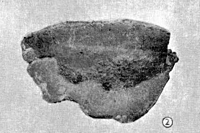|
 Loweporus roseoalbus Loweporus roseoalbus
SynonymsPhellinus endapalus
Fomes awhitu
Fomes endapalus
Polyporus endapalus
Polyporus roseoalbus
BiostatusPresent in region - Indigenous. Non endemic
Images (click to enlarge)
Caption: Fig. 2. Fomes awhitu, x 2/3. Effused-reflexed specimen showing hymenium with minute pores. |
Article: Cunningham, G.H. (1948). New Zealand Polyporaceae. 8. The genus Fomes. New Zealand Department of Scientific and Industrial Research, Plant Diseases Division, Bulletin 79: 24 p.
Description: Hymenophore perennial, dimidiate, imbricate, soft but firm, light. Pileus narrowly applanate,
effused-reflexed, often resupinate, with occasional orbicular outlying islands, 6-20 cm. x 2-5
cm. x 0.5-2 cm.; surface even or obscurely concentrically zoned, dull, finely pubescent or as
often glabrous, bay-brown, umber, sometimes violaceous, almost black in old specimens,
cuticle wanting; margin bluntly rounded, even, entire, concolorous; hymenial surface slightly
glancing, even, fawn, bay-brown, rose-pink or violaceous when fresh, becoming tobacco-brown, sterile border 1-5 mm. wide, lighter in colour, dissepiments not toothed. Context
fawn, bay-brown or chestnut-brown, 1-3 mm. thick, of loosely woven hyphae; skeletal
hyphae 4-4.5 µ thick. lumen 2 µ, light fuscous, tapering, branched and undulate near ends,
aseptate, staining; generative hyphae hyaline, thick, delicate walled, septate, branched. Pores
stratose, round, 1-5 mm. deep in each layer, bay-brown, chestnut-brown or violaceous in
section, 100-150 µ diameter, commonly 50µ, or 7-9 per mm.; dissepiments 50-100 µ thick,
commonly 50 µ, equal or tapering slightly, apex finely velutinate. solitary or imbricate on
hark or decorticated wood of fallen trunks, associated with a white rot. Basidia clavate, 8-10
x 3.5-4 µ, soon collapsing. Spores oblong with rounded ends, 3.5-5 x 2-3 µ, smooth, yellow-brown, abundant.
Habitat: HABITAT: Growing solitary or imbricate on bark or decorticated wood of fallen trunks,
associated with a white rot.
Distribution: DISTRIBUTION: New Zealand.
Notes: Specimens are variable in size, shape, and colour. Most are effused-reflexed, a few
resupinate. In fresh specimens the hymenial layer may be coloured rose-pink, some shade of
brown, or violaceous. The species may be recognised readily by the light weight of the
hymenophore, oblong coloured spores, minute pores, thin dissepiments, and fuscous skeletal
hyphae which, though coloured, stain blue readily.
|